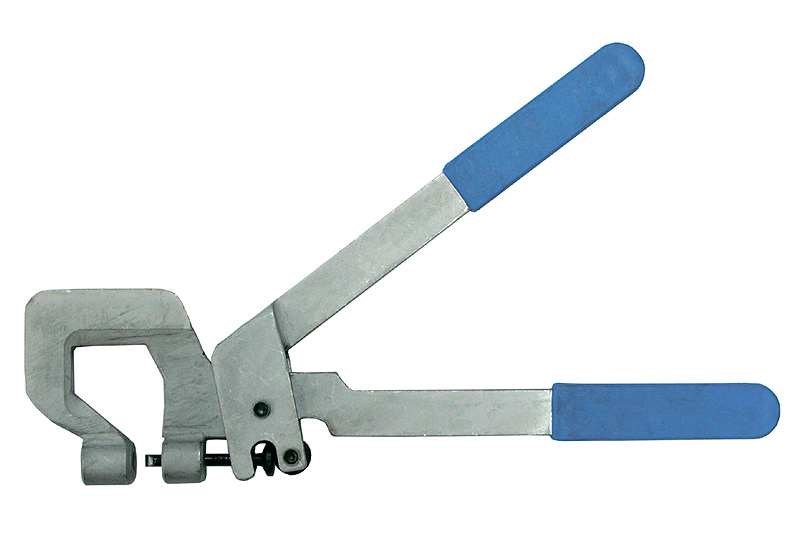This publication is for those who are planning to purchase a manual cutter for installing metal profiles under drywall. Selection advice will be based on my personal experience metal profile installation work. And I have quite a bit of experience, about 20 years.
First, before purchasing, decide for yourself how often you are going to work as a cutter. If you need to make repairs at home, then there is no point in buying an expensive cutter. And vice versa, if you plan to install metal profiles professionally, then it is better to buy an expensive and high-quality tool.
Choosing a cutter for professional use
For anyone faced with the professional installation of metal profiles, the main factor when choosing a tool should be time. The level of income of the installer depends on the speed of installation. The second most important factor is the reliability and quality of the tool. The third factor is the reliability of the mounting location. And the last factor should be the price of the tool.
As for the frame cutter, the first factor for the pros is ease of use. This factor directly affects the installation speed. Choose a cutter with short handles that fits comfortably in your hand and cuts through the metal profile with little effort.
Below, for example, is an EDMA cutter with long handles. From my work experience, I will say that working with such a tool requires two hands, which is extremely inconvenient. It is necessary to involve an assistant during installation, which affects the installation time.
But with this EDMA cutter with short handles, I can easily work with one hand, thereby I don’t need an assistant and the installation speed doubles.

Quality and reliability of the cutter
The service life and therefore the level of your income depends on the quality of workmanship. Based on my operating experience, I can identify several companies. This is the Edma company, their cutters are very reliable, they last at least 15 years. But there is one drawback: the return spring of the cutter breaks.
Separately, it is worth highlighting the Knippex cutter. This is a very high-quality tool, but its price is significantly higher. The service life can reach 25 years.
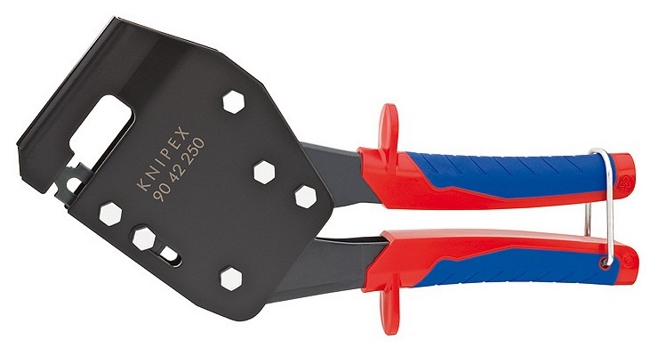
In terms of the quality of the frame attachment point, all the models described above do an excellent job.
Having experience working with these models, I can recommend them for professional work.
Choosing a cutter for one-time work
For those who are not going to use a cutter often, here are some tips for choosing.
There are inexpensive cutters on the market and they cope with the task quite successfully. Sometimes some inconvenience may occur. For example, a Topex cutter is not very convenient to insert into the frame. But the connection point turns out to be very reliable.
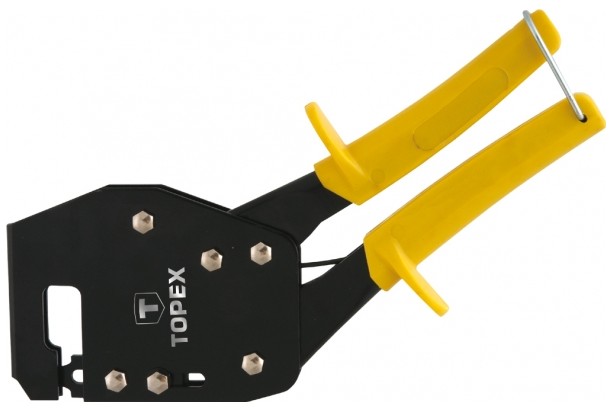
Even for one-time work, I advise you to choose a cutter with short handles. Among the inexpensive ones on the market, there are also models like the one in the picture below.

All the cutters that I described above have been tested by me personally. They all successfully cope with their task. The difference between them is in the quality of workmanship and, accordingly, the price.
Every master knows that before installing plasterboard slabs, you must first make a steel frame. Traditionally, self-tapping screws are used as fasteners. However, in this case, you cannot do without a screwdriver and a strictly defined amount of fasteners (purchased, moreover, with a reserve). Alternative technology cutting a steel profile with a special tool is considered. That's what they call it - a cutter for metal profile under drywall - although a similar method of fastening can be used in other situations.
Design and types of cutters
The mechanics of operation of a metal profile cutter are very similar to the operating principle of a conventional office stapler. In both cases there is a lever mechanism that creates the necessary technological force for cutting - dividing a part of the workpiece along an open contour.
The tool consists of the following components:
- A progressively moving punch - a steel punch with a triangular working part.
- Lever drive for moving the punch.
- Stop with a recess for fixing the profile.
- A rotary handle, pressing which produces movement of the power lever of the cutter.
- Return spring.
- A fixed support handle that prevents the tool from slipping while cutting.
- A loop designed to store a tool when not in use.
Various manufacturers of the equipment in question may make unfundamental changes to this scheme, but the principle of operation remains the same.

The cutter for metal profiles for plasterboard is manufactured in three main modifications:
- Manual cutters that are designed for self-production fastening operations. They are small in size and light in weight due to their use aluminum alloys as materials of main components. However, the capabilities of such devices are also minimal;
- Semi-professional, reinforced cutters are distinguished by a more complex, but also more advanced kinematics of movement of the working parts, which ensures the creation of increased force during operation. The punch in such devices is removable, which increases the durability of the equipment (however, it is worth noting that punches different companies are not interchangeable with each other);
- A professional tool, the design of which provides for mechanical reinforcement of the transmitted load due to the use of multi-link lever mechanisms. Such cutters are the most massive and expensive, and therefore pay for themselves only with regular use.
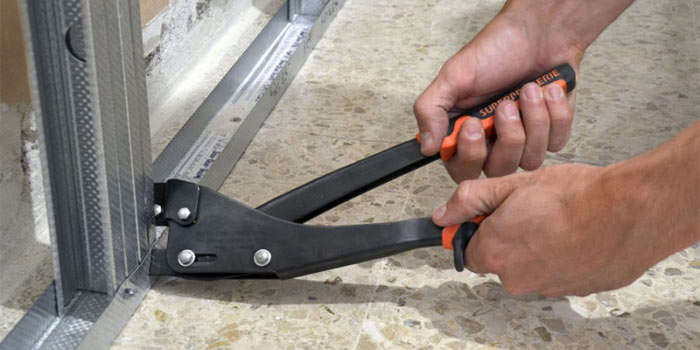
The principle of operation of a reinforced type cutter
The tool is placed with its support bracket in the gap between the parts of the metal profile, where they need to be connected. The punch is in the rearmost position, held by forces return spring, and the handles of the instrument are spread apart. The back surface of the bracket should rest on the back side of the profile, and its leg should rest on its front part.
After making sure that both elements to be connected are accurately positioned, the worker presses the movable handle of the cutter with the back of his hand. At the same time, the V-shaped rocker arm, which ends the movable handle, begins to move in the horizontal guide slot, pushing the punch forward. The straightness of the punch's movement is ensured by two centering axes (on the handle and the body), a profiled groove in the rocker arm and a mounting hole for the punch in the bracket itself. The three-lever mechanism increases the initial force to values at which the shear resistance of the metal is overcome. Its part is separated from the base of the profile and pressed into the adjacent element steel frame. In this case, such a depth of penetration into the material is achieved that ensures the reliability of connecting the parts of the metal profile to each other. WITH inside a characteristic furrow is formed.

When the movable handle of the punch is released, the compressed spring straightens and, moving along the angular groove of the rocker arm, returns the punch to its original position. The rocker arm rotates and provides the movable handle with reverse movement.
The intensity of pressing is controlled by the worker, and, depending on the thickness of the metal profile and its structure, determines the cutting force and the stroke of the punch.
In order to ensure proper operational durability of the tool, the bracket of the metal profile cutter for plasterboard is made forged (less often from cast steel), the spring is made of durable high-carbon steel, and the punch is made of tool steels of type U7 or U8.
How to choose a cutter?
The initial selection criteria are:
- The type and thickness of the original metal profile. Most models work with profiles up to 0.6 mm thick.
- Free movement of the handles (as it increases, the demand for the cutter increases).
- Maximum applied force.
- Functionality, in particular, the ability to use the tool not only for working with drywall, but also for fastening other household items.
- Dimensions of the finished groove in plan.
The tool should not leave marks from its use on the front panels of the products being connected, which is easily installed when purchased in specialized stores. The forming cuts must be smooth and without scoring.
Like the method of joining with semi-hollow rivets, perforation has its limitations. In particular, if the connection is made incorrectly, it is quite difficult to correct the error. You should use this method with caution when fastening frame elements in rooms with high humidity, since there is no galvanization on the side surfaces of the groove. Nevertheless, cutters are used quite often: they are cheaper than screwdrivers, and, moreover, when using them, the problem of self-tapping screws constantly getting lost somewhere disappears.
It is also important where and by whom the metal profile cutter for drywall was made. The most popular among inexperienced consumers are Chinese-made products; they attract, first of all, their low price, as well as the ease of grip of the handles. However, in most cases, low-quality steels and alloys are used for the manufacture of such equipment. Therefore, the bracket on a cheap cutter can very quickly collapse, the spring can burst, and the punch can become dull. In addition, some models do not provide the ability to replace the punch, so the consumer has no choice but to sharpen the worn tool directly in the body. This is very inconvenient, and the quality of sharpening leaves much to be desired. At the same time, the length of the punch is reduced, and therefore, an increased stroke of the movable handle will be required, which is not always provided for by the design of the product.
On the opposite side in price are tools produced, for example, by the famous Knauf brand. They are multifunctional, reliable, and all critical parts are made from high-quality steel grades. The disadvantage of such products is that they are adapted to their Construction Materials, and is expensive.
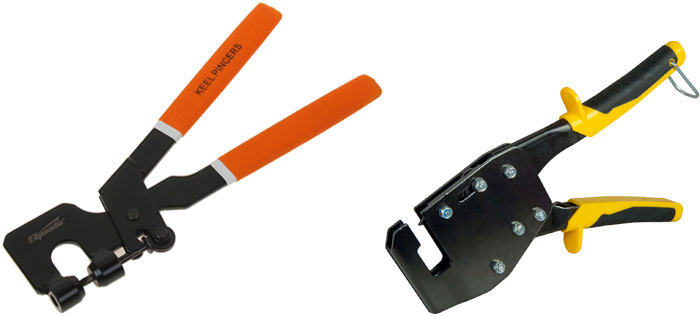
In the middle price range there are products from brands Matrix, Spartа, Stanley, Fit and Knipex. The latter, for example, is recommended for one-time work of relatively short duration. Among the domestic tools, it is worth taking a closer look at the cutters of the Prok company: they are made from quality materials, and have a large margin of mechanical strength.
Recent consumer ratings of products for this purpose indicate that cutters for metal profiles for plasterboard, model 87950, produced by the German brand Matrix, are beginning to enjoy increasing popularity. With their quite budget price - 620...660 rubles - they are distinguished by ease of use, relatively light weight, and reliability during operation.
Metal profile cutter 87952 from Sparta SanTool – also good choice from the same price category.
Today, drywall is very popular. It is used to level walls, create partitions and decorative structures. GKL is mounted on a metal profile lathing, individual elements which are fastened with special screws. However, their caps sometimes interfere with a tight fit plasterboard sheets. To avoid this, a drywall cutter is increasingly being used.
What it is?
This tool began to be used in construction not so long ago. Most ordinary users and home craftsmen have little idea what a cutter for a drywall profile is, how it works, and on what principle it works.
Externally, the tool resembles pliers: it has 2 handles, one of which has a bracket attached to the end. The second one is installed cutting element(punch). The principle of operation is also very simple: 2 profiles are combined, the connection point is placed between the bracket and the punch, the handles are pressed, and a hole appears on the metal (it is also called a groove), which holds the profiles in a given position. Some devices on the reverse side press the protruding edges tightly, some do not.

Types of cutters
There are 3 types of cutters for metal profiles for drywall:
- regular manual;
- reinforced;
- professional.
They are all designed the same, but have some differences. First of all, this is the load for which they are designed and operating conditions.
Manual cutters have small size. They fit comfortably in one hand. Most often, this type of tool is used by home craftsmen. Their safety margin is quite enough for small repairs in an apartment, and they cost much less than their professional counterparts.
Reinforced cutters are most often purchased by small construction teams. These tools are made from stronger alloys. They also differ slightly in design: they usually have a removable punch, which is easy to change if it gets dull. Thanks to this, the tool will last longer.
Professional tools are usually used for large volumes of work. They are larger and more massive than their analogues, more powerful, and can penetrate thicker profiles. Of course, such a cutter costs much more than its “brothers”. There is no point in purchasing it if you plan to build one partition.
These features must be taken into account when choosing a tool. The most popular at the moment are reinforced cutters.

When choosing a suitable device, you need to pay attention to several more parameters:
- Thickness of the metal being pierced. For example, 0.55 mm – standard thickness for manual models, a reinforced cutter is capable of making a hole in a profile 1.5 mm thick.
- Hole diameter. Varies from 2 to 5 mm depending on the choice of interchangeable bits that come with the tool.
Benefits of using a cutter
Installation of profiles using a cutter is noticeably different from the classical method, which involves the use. The advantages that this type of fastening has:
- savings on consumables– self-tapping screws;
- no installation required additional tool(drill, screwdriver);
- profiles are not deformed;
- there is no risk that the screw will go too far;
- no need to waste time on marking;
- a hole is punched much faster than a self-tapping screw is screwed in;
- the holes have smooth, neat edges, nothing sticks out of them;
- no dents on the frame;
- does not consume electricity;
- The connection is reliable, but if necessary, it can be quickly and easily disassembled.
Many builders, after working with a cutter, refuse to use self-tapping screws, since the process is significantly accelerated and simplified.

How to use the tool
Using a cutter for a metal profile for drywall will not require any special skills or special abilities from its owner. The frame elements are connected very simply:
- profiles are aligned relative to each other and fixed in the desired position;
- the handles of the cutter are moved as far as possible in different directions;
- the ear is placed so that the connection point is between the lip and the cutting element;
- the handles are squeezed sharply, as a result the punch makes a hole in the profile;
- the handles are again moved apart and the tool is moved to the side or removed.
Thus, the profiles are connected to each other.
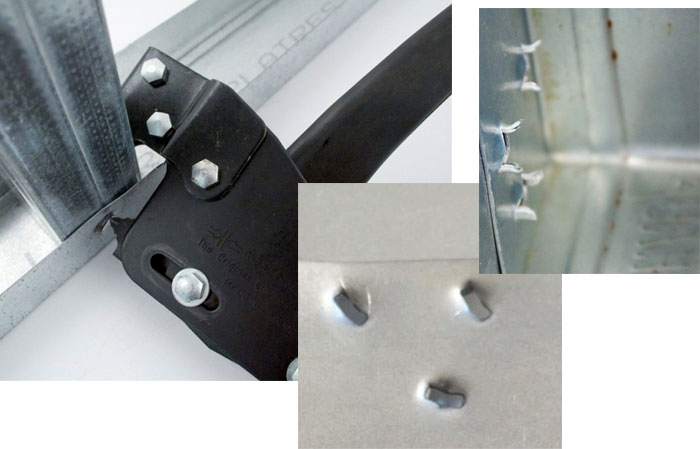
A cutter is a very simple and undemanding tool, but it also requires proper care and compliance with some rules:
- most cutters are designed for a total profile thickness of no more than 1.5 mm;
- you can’t make breakthrough breakthroughs;
- hitting is also prohibited;
- The cutter must be placed strictly perpendicular to the plane of the profiles being pierced;
- you cannot make a breakdown in the place where the profile is built up or joined;
- The hinges need to be lubricated periodically.
Profile cutter for drywall - simple and handy tool. Even a beginner can assemble a frame with its help.
A cutter is a special pliers for connecting two profiles and creating holes in them. The holes made by the cutter look neat and all of them same size. And fastening metal (or aluminum) profiles using this kind of stapler is done without much labor.
Which cutter for connecting profiles choose
To purchase pliers for fastening, you need to decide on the types and types offered to us by manufacturers. By design, cutters are as follows:
Manual– reliable, ideal for beginners in repair. They look like pliers with a long handle. When the pliers are brought together, a groove is formed - the profiles are fastened together. These pliers are brought together with two hands, less often with one. That is, to work with the tool for a long time, endurance and physical strength are required.
Pneumatic– more professional cutters, which are a system of levers that allows you to simultaneously punch several holes. A pneumatic drive is capable of developing quite a large force with little force applied by a person. This type is classified as a desktop cutter (work is performed in a horizontal plane). The main advantage of the models is the availability of a punching kit with diameters from 2 to 10 millimeters (0.1 steps). There are also manual models, more compact and easy to use, for punching one hole in any position (vertical, horizontal).
Machine tools– used primarily in industrial production. They are equipped with a pneumatic or electromechanical drive. They can operate in automatic or semi-automatic mode.
The first type of tools is used more often in everyday life. In turn, this type is divided into simple And reinforced models. Reinforced ones provide for the replacement of cutting edges, and the tool materials themselves are stronger and more durable. It can be used not only for installing plasterboard walls (read a good one about this), but also for punching various kinds of holes. For example, a keyhole.
Also cutters are special or universal(punching holes in profiles of different thicknesses).
To purchase pliers for fastening profiles, you need to decide on the types and types offered to us by manufacturers.
Manufacturers and prices of cutters
The following brands are very popular among builders: cutters for connecting profiles:
- Tsentrinstrument (Russia) – manual models from 300 rubles;
- Matrix (China) - average cost 614 rubles (simple manual model);
- Topex (Poland) - the average cost of manual models is from 1100 to 1470 rubles;
- Knipex (Germany) – manual models from 6,700 rubles;
- Stanley (USA) - a reinforced model from the leader in the production of hand tools with the ability to squeeze with one hand costs 7,500 - 9,200 rubles.
Despite the differences in price, the cutters are the same in operation. The choice mainly depends on the preference of the company and financial capabilities. More expensive professional models, of course, are more durable than their cheap counterparts.
Buyer advice:
- If you plan to use it regularly, it is better to purchase a professional model.
- For a one-time repair, a cheap model from a lesser-known manufacturer is quite suitable.

The cutter is easy to use—spread the handles apart and sharply close them together. The hole is ready.
How to properly connect two drywall profiles to each other
Using a cutter is no more difficult than using a stapler.
- Place aluminum or metal profiles in the desired positions under the right angle between themselves.
- Spread your arms.
- Place the working hook between the profiles.
- Bring the handles together sharply until they click.
- The result is a notch for the profiles, and a groove on the reverse side.
- Open your handles and start working with the following profiles.
How to work with a cutter correctly?
Cutter for connecting profiles, like any instrument, requires careful handling. To maintain its functionality for as long as possible, you must follow simple rules:
- the thickness of the fastened profiles should not exceed one and a half millimeters;
- jerks and impacts during work are unacceptable;
- the center of the punch during installation must be perpendicular to the surface to be fastened;
- moving parts of the tool are regularly lubricated with machine oil;
- It is undesirable to touch the joints of the profile - this will cause nicks to appear on the tool.
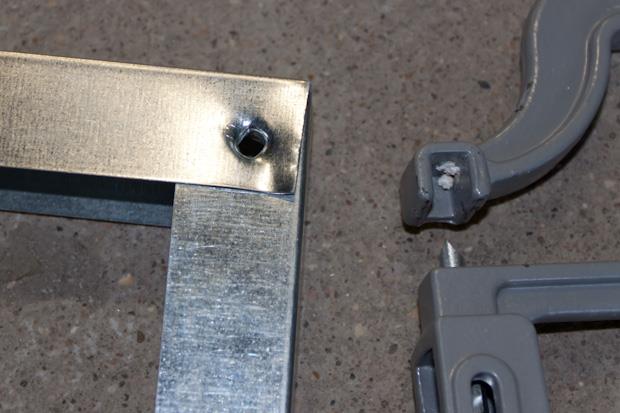
This is what the finished product looks like gusset profiles with a cutter
Compliance with all of the above conditions allows the tool to perform up to 3000 profile cuts (0.55 mm) without replacing the cutting edge.

What to remember when working with a cutter
- When choosing, be sure to pay attention to the limit on the thickness of the materials being fastened; it differs for different models.
- And to extend service life it is necessary to use for lubrication machine oil. It is better to purchase it at the same time as the tool.
- It is advisable that cutting edge replaced when worn out. In cheap models, the cost of repairs is sometimes more price the instrument itself. Therefore it is easier to purchase new tool than to fix it.
Repair and replacement of components
- The matrix and punch, which allow you to change the size of the punched holes, are easily changed. However, frequent reinstallation of parts will lead to rapid wear of the mounting holes. Sometimes it makes more sense to have several cheap tools available. different size fastenings than one expensive one, but requiring constant change of the matrix and punch.
- It is better to replace the cutting element in a repair shop. There it will be installed efficiently and reliably. The dropped springs are also inserted here.
- The rubber covers of the handles should be replaced periodically.
- This tool is successfully used for punching holes in thin and brittle materials. For example, plastic.
- You can also use it to make a keyhole, or use it to punch holes in wooden parts.
- It makes not only round, but also polygonal or oval holes (this depends on the cutting edge).
Advantages of working with a cutter
Ease of use, quality of work, availability and a wide selection of models make cutters a popular tool used by both professionals and beginners. It has many undeniable advantages:
- no dents on the frame;
- are not required (and this is a significant budget saving when large area rooms);
- the holes do not need to be further processed - they are perfectly smooth;
- there is no need to make preliminary markings - all holes will be at the same distance.
Learning to use hand cutters is quite simple. Taking the tool in hand and making a few fasteners, any man turns into a real master of covering rooms with plasterboard. Have an easy repair!
Today, drywall is considered simply an irreplaceable material that is used during repair work. With its help you can build the most various designs in absolutely any room. However, plasterboard cannot simply be mounted on the surface of the ceiling, walls, or made into partitions. It is attached to a metal profile, which requires a special tool to work with - a cutter. Most important part The cutter is the area for connecting parts, which consists of a bit and a matrix. Both of these elements most often fail, which is why it is advisable to purchase components in advance that will suit all parameters. This tool is similar to an industrial stapler, but it does not have staples and instead has special tabs. You should not replace the matrix very often, as this may lead to tool malfunction.
What to base your choice of profile cutter for drywall
It is very important to choose the right cutter for a metal profile, since when installing drywall sheets you will have to work with it quite often. That is why, in order for the tool to last as long as possible, it is necessary to pay attention to its quality.
The cutter for metal profiles for plasterboard sheets has a fairly simple device and consists of:
- Two extended handles;
- Working part;
- Connecting parts.
Depending on what material this tool will work with, the thickness of the holes made varies. For example, a cutter with a reinforced mechanism can make holes .5 mm thick, while the simplest manual models can make holes only 0.55 mm thick. Taking into account absolutely all the available characteristics of the tool, you can select a cutter for profiles with the required parameters and obtain the required result.

When choosing the most suitable model, it is worth considering that the cutter can be:
- Manual;
- Machine;
- Pneumatic.
A pneumatic tool helps connect several elements together, bend or vice versa, bend a frame or cut corners. Hand tool used for the same purposes as pneumatic, but it is mainly used for repair work.
All these models differ in power, manufacturer and range of applications. All cutters are small in size, which provides special convenience when working with the tool. To work with durable materials, a more reinforced version of the tool is used. Its special design provides fairly good strength, thanks to which the tool serves for a long time, and the cutting part can be very easily replaced if necessary.
In addition, there may be professional models of tools that are used in the process of redevelopment of premises and during repair and finishing works. It is worth noting that the cost of such tools is quite high, so they are used exclusively by professional builders.
When choosing the most suitable tool it is necessary to initially determine the scope of its application, and also proceed from what requirements are imposed on this tool. If it is necessary to carry out various construction and renovation work, then you need to purchase several cutters at once to work with different instruments and materials, depending on their strength. This will significantly save time and make the work better.
Rules for working with a drywall cutter
Working with a metal profile divider is quite simple and even the most inexperienced person can handle this work.
The metal profile cutter works as follows:
- It is necessary to place the tool in the required place;
- Open the handle and mark the location for the future hole;
- Quickly bring the handles together;
- Remove the tool.
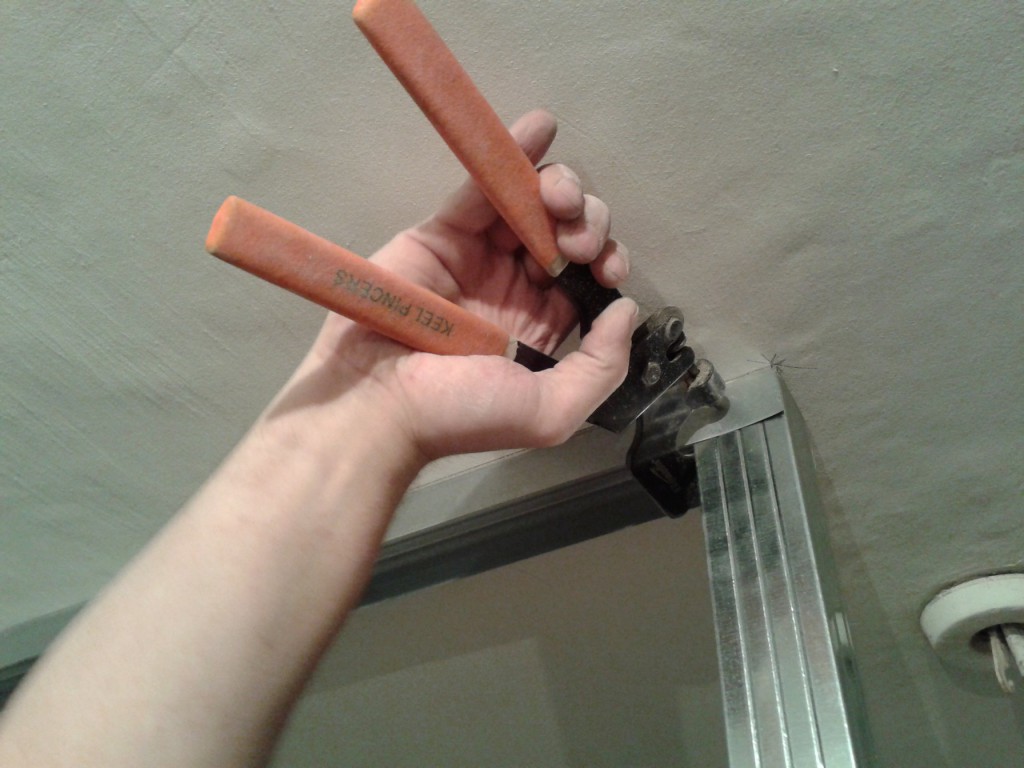
As a result of all these manipulations, two metal profiles will be connected to each other, and a groove will form in their place. The tool has such parts as a matrix and a punch. They can be easily replaced if it is necessary to make holes of different sizes. That is why it is best to immediately purchase additional kits so that you can perform work of varying levels of complexity depending on the density of the material.
Important! The connection of profiles using a cutter is carried out quite firmly, so a frame secured in this way can withstand even the heaviest loads.
Why do you need a cutter for gypsum boards?
Work related to drywall requires a metal profile. To be ready metal structure formed a single whole, it is necessary to use special tools for connection.
A professional cutter for metal profiles when working with plasterboard sheets is simply necessary for:
- Carrying out work during construction;
- Complete remodeling of the room;
- Wall and ceiling finishing.
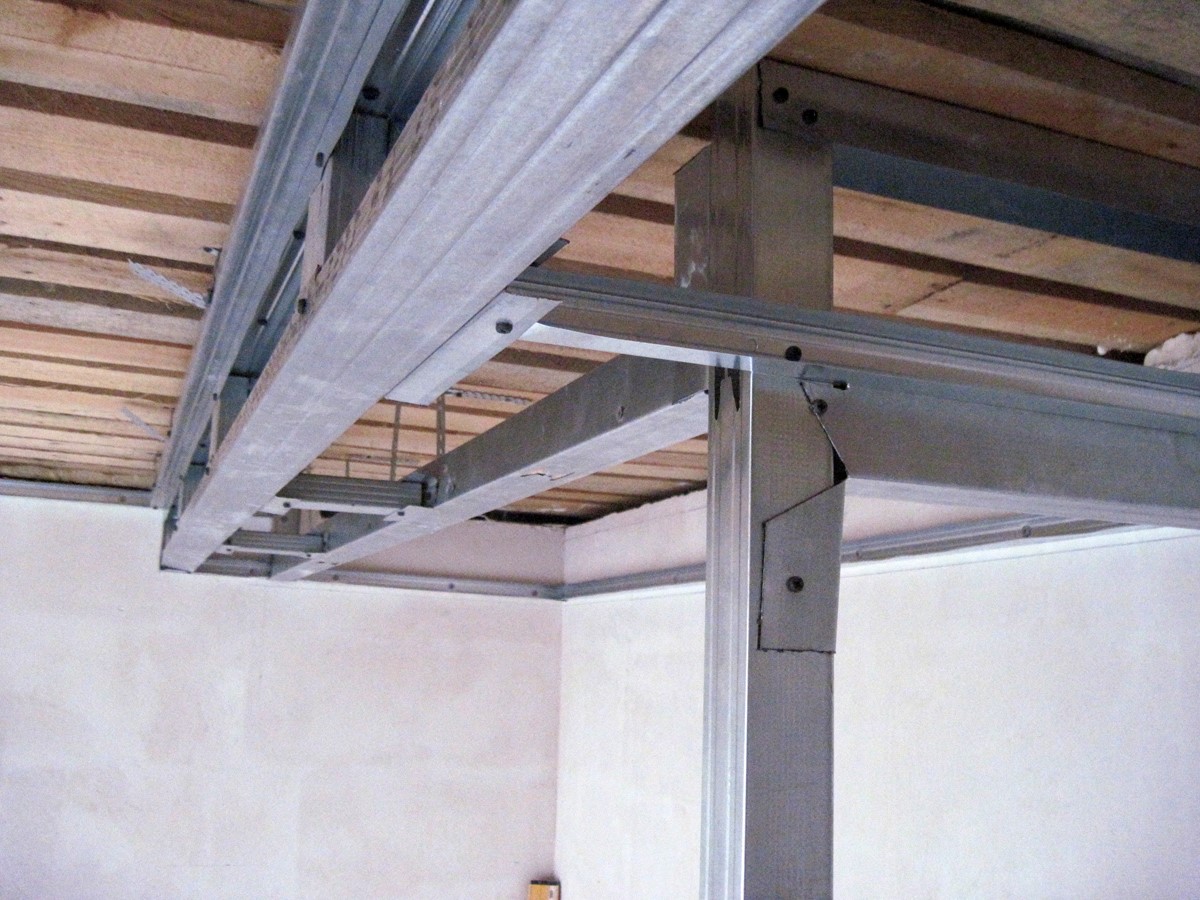
Using a cutter during work, profiles can be fastened together. Using a metal profile cutter, you can easily and quickly assemble the required frame parts. This tool is simply irreplaceable when constructing the required interior partitions, wall decoration, room redevelopment.
When carrying out repair and finishing work, the most important thing is to follow all the required operating rules for this tool, since only in this case can a guaranteed good result be obtained.
The cutter is quite easy to use and reliable tool, which has good feedback, both users and professionals. However, there are certain nuances that you should definitely pay attention to when purchasing this tool.
In particular it is necessary:
- Immediately purchase a set of replacement parts;
- In case of breakdown, contact a specialist;
- Select models exclusively from trusted manufacturers.
